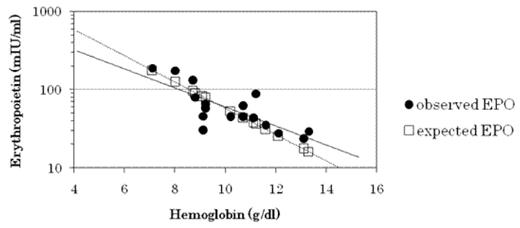Abstract
Serum Erythropoietin dose not Participate in Anemia that Persists in CML Patients after MMR Achievement by Imatinib Mesylate Therapy
The IRIS study revealed that imatinib mesylate (IM) has resulted in durable responses in patients with CML in early chronic phase. Overall, 86% of patients on IM achieved complete hematologic response (CHR) by 3 months and 78% achieved complete cytogenetic response (CCR) by 18 months.
According to the European LeukemiaNet guidelines, CHR is defined without evaluation of anemia. In the IRIS study, grade 3 or 4 of anemia was reported as 4% after 5 years of therapy, however, we found most patients remain mild to moderate anemia even after achievement of major molecular response (MMR). Persistent anemia sometimes deteriorates patients’ quality of life and is thought to be clinically important.
Here, we investigated frequency and severity of anemia, and participation of serum erythropoietin (EPO) among 23 patients, who have achieved MMR by IM at doses in excess of 300mg for more than 2 years. At diagnosis, the median age was 53 years (range 20–87) and 14 were male. 20 patients were in chronic, and 3 in accelerated phase. Median leukocyte count was 31.6 × 109/L (range 4.1–216.3 × 109), median hemoglobin (Hb) was 13.1 g/dl (range 6.2–16.2), and median platelet count was 629 × 109/L (176–1640). The cumulative rate of CHR by 3 months was 100% and that of CCR by 12 months was 77.3%. Among 18 patients who had MMR, hematologic adverse events were assessed. After reaching MMR, leukocytopenia was observed in 3 (16.6%) patients (grade 2; 2pts, grade 3;1pt), anemia was in 13 (72.2%) patients (grade 1; 10pts, grade 2; 2pts, grade 3; 1pt), and thrombocytopenia was in 3 (16.6%) patients (grade 1; 2pts, grade 2; 1pt). Mild to moderate anemia tends to persist at high rates as compared with other cytopenias. In anemic group, median MCV, MCHC, and reticulocyte was 99.4fL (range 91.6–113.1), 33.3% (range 30.4–35.2), and 53691/micro L (range 30450–72324), respectively, and serum urea and creatinine were normal. To reveal mechanism of persistent anemia, EPO levels were measured by a radioimmunoassay (normal range 9.1–32.8 mIU/ml). For control, we used the formula: log[EPO]=3.436–0.1675[Hb], which was led by 58 iron deficiency anemia (IDA) patients and had been previously reported (
In conclusion, grades 1–2 anemia frequently persist in CML patients after MMR achievement. The EPO response does not concern about the condition of persistent anemia, and IM have little influence on the serum levels of EPO.
Disclosures: No relevant conflicts of interest to declare.
Author notes
Corresponding author


